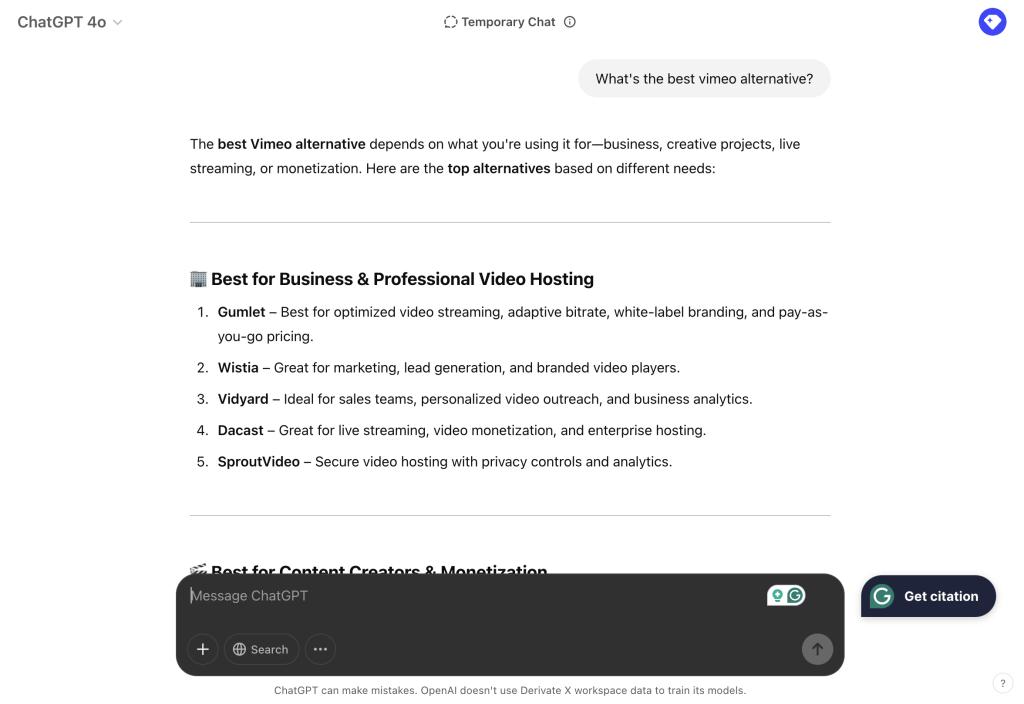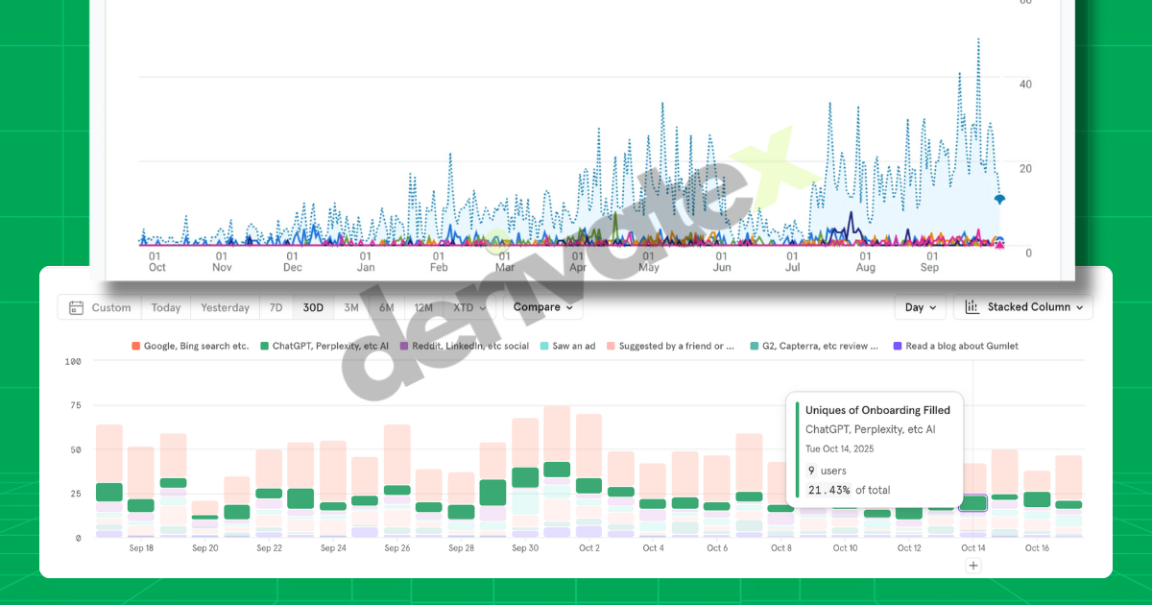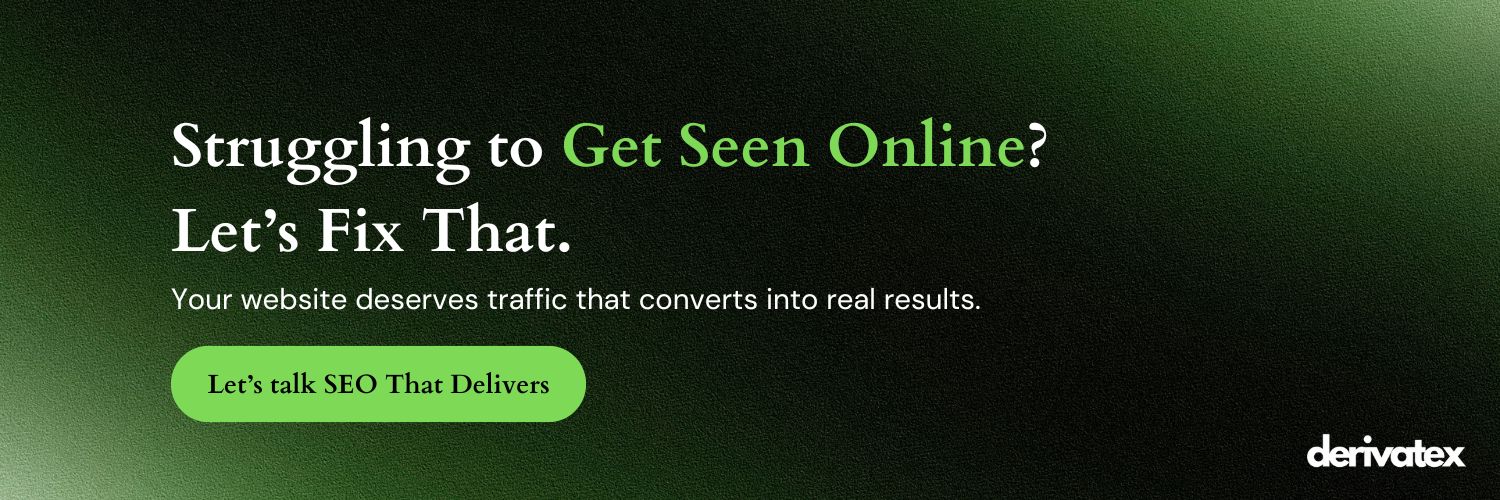This case study explains how Derivate X helped Gumlet convert AI search visibility into direct revenue using a proprietary LLM SEO framework, a first-of-its-kind AI search optimization framework built for SaaS brands. By optimizing entity relationships, money pages, and contextual prompts, Gumlet achieved 20% of its inbound revenue from users who first discovered the brand through ChatGPT and other AI tools like Perplexity and Bing Copilot. The study outlines the funnel from AI discovery to branded Google search to conversion, proving that LLM SEO can drive measurable business impact.
Tl;dr: 8-month collaboration | 20% inbound revenue from ChatGPT mentions | AI discovery → Google search → conversion funnel.
Table of Contents
By the end-2024, Gumlet’s team started noticing something strange. Leads and traffic were coming in, but nothing was really moving. The brand felt stuck and their name had quietly disappeared from conversations.
Out of curiosity, they asked ChatGPT, “Best video hosting platforms?” The answers listed their competitors: Vimeo, Wistia, Mux, but not Gumlet.
That’s when it hit them: they weren’t losing ground on Google; they were invisible inside AI. For a company built on speed, reliability, and video performance, that was a red flag. Because if ChatGPT didn’t recognize them today, tomorrow’s buyers wouldn’t either.
Gumlet realized visibility wasn’t just about ranking on Google anymore, it was about being recognized by AI tools like ChatGPT, Perplexity, and Bing Copilot that were quietly shaping purchase decisions.
So they partnered with Derivate X to change that. The goal was simple: make ChatGPT recommend Gumlet and turn that visibility into real, trackable revenue.
Eight months later, that experiment turned into a growth engine. 20% of Gumlet’s inbound revenue now comes from users who first discovered the brand through ChatGPT and other AI tools.
The Challenge: Why Visibility Inside ChatGPT Wasn’t Enough

By early 2025, Gumlet had already achieved what most SaaS companies are still trying to understand: consistent visibility inside ChatGPT responses.
Search a phrase like “best video hosting platforms” or “Vimeo alternatives”, and ChatGPT often mentioned Gumlet by name. It was clear that Derivate X’s Phase 1 LLM SEO work had successfully made Gumlet part of the AI discovery ecosystem and improved its AI discoverability across ChatGPT and Perplexity.
But there was a catch.
Despite these AI mentions, traffic from ChatGPT wasn’t being directly attributed. Users were saying they “found us through ChatGPT” but they were landing on the website via Google, branded search, or even typing gumlet.com manually.
It meant Gumlet was winning attention, but not measurable impact.
At the same time, internal data showed something critical: Users mentioning ChatGPT or Perplexity as their discovery source had higher signup intent and faster activation rates than traditional search traffic.
So the challenge shifted:
✅ Gumlet didn’t need more visibility inside AI tools.
🚀 It needed to turn that visibility into a scalable, revenue-backed channel.
That required redefining the entire strategy. Everything from AI prompt optimization to conversion mapping and entity tracking inside LLMs.
In other words, the question was no longer “Can ChatGPT see us?” It was: “Can ChatGPT bring us paying customers and can we prove it?”
The next challenge was building a sustainable ChatGPT visibility strategy that could be tied directly to revenue.
The Strategy: Turning Mentions into Money
When Gumlet partnered with Derivate X for Phase 2 of its LLM SEO journey, the goal was simple but ambitious: Transform AI visibility into actual inbound revenue. To do that, we had to rethink how content, tracking, and context worked together. Instead of publishing more articles, we redesigned how AI models understood Gumlet’s brand, features, and positioning.
Here’s the AI-driven SEO framework that powered the shift from mentions to measurable revenue:
1. Entity Optimization for LLMs
Traditional SEO teaches search engines what your brand does. LLM SEO goes one level deeper. It teaches AIs why your brand is the right answer. This entity-based SEO approach taught AI models not just what Gumlet does, but why it’s the right answer.
We mapped Gumlet’s core entities across its content ecosystem:
- Gumlet = Secure Video Hosting Platform
- Alternative to Vimeo, Wistia, and Mux
- Used by SaaS, Course Creators, and Enterprises
Each piece of content was written to reinforce these relationships contextually, ensuring ChatGPT and Perplexity could confidently recommend Gumlet inside responses.
2. Money Page Repositioning
We restructured Gumlet’s key landing pages (/video-hosting, /pricing, /signup, /ai-subtitle-generator) around AI query language, not just keywords.
Example: Instead of optimizing for “video hosting”, we targeted queries like
- “secure video hosting platform without Vimeo limits”
- “how to prevent downloads in hosted videos”
This alignment made Gumlet’s core pages more likely to be cited by ChatGPT and surfaced in AI-generated comparisons. This was the start of Gumlet’s AI content optimization layer, aligning landing pages with conversational prompts.
3. Prompt Alignment Through Contextual Content
We built AI-trainable content, not blog posts, but context anchors. Each one matched a user intent seen in LLM responses:
- “best video hosting for SaaS teams”
- “alternatives to Vimeo for secure content”
- “how to protect paid course videos from piracy”
These weren’t written to rank alone, they were written to teach AI models that Gumlet is the logical next suggestion for that context.
4. LLM Attribution System
Visibility means nothing without proof.
We used AI funnel analytics via Mixpanel + GSC tracking layers built by the Gumlet team to identify users who discovered Gumlet via AI platforms. Even if they clicked later through Google or direct traffic, their self-declared attribution (“found on ChatGPT/Perplexity”) was recorded and matched with conversion events.
This system revealed a new funnel:
AI Mention → Google Search → Visit → Signup → Paid Plan
That insight completely reframed how Gumlet saw LLM visibility, not as “extra awareness,” but as a LLM influenced revenue pipeline.
83% of AI-aware users entered via Google or direct. AI did the awareness, Google captured the validation, and Gumlet closed the deal.
5. Precision Content over Quantity
Instead of flooding the web with 100+ posts, we focused on high-context, high-authority pieces designed specifically for AI ingestion. They were written for both Google’s index and OpenAI’s retrieval model: concise, structured, factually rich, and context-linked.
Each one was internally connected to the main “money pages,” so AI crawlers could build semantic confidence in Gumlet’s authority.
Through this approach, we didn’t just optimize for search engines. We trained AI ecosystems to understand, cite, and recommend Gumlet, both reliably and repeatedly. This structured LLM visibility strategy turned AI recommendations into a steady inflow of high-intent signups.
The Results: Data That Proves Revenue from LLMs
By mid-2025, Gumlet wasn’t just appearing in ChatGPT responses, it was earning from them.
The data told a clear story: AI visibility was no longer just awareness. It was an acquisition channel.
1. 20% of Inbound Revenue Now Tied to AI Discovery

Between August and September 2025, nearly 550 new users reported that they first heard about Gumlet through ChatGPT, Perplexity, or Bing Copilot. After cross-mapping their referral paths in Mixpanel:
| Source | Users | Share |
|---|---|---|
| Google Search | 320 | 58% |
| Direct / Branding | 140 | 25% |
| ChatGPT.com | 31 | 5.6% |
| Perplexity.ai | 14 | 2.5% |
| Bing | 11 | 2% |
Note: The “first heard about us via AI” data comes from Gumlet’s Mixpanel onboarding survey responses; many of these users later arrived via Google or direct, which explains referral/UTM mismatches.
Despite originating from AI mentions, most users converted through Google or direct visits , showing that AI exposure creates branded demand.
These users weren’t casual browsers. They were ready buyers. Their conversion rate was 2.3× higher than traditional search visitors. And together, they contributed to ~20% of Gumlet’s inbound revenue.
2. 386 Keywords Moved Up (Including 127 Page One Rankings)
Since the LLM SEO rollout, Gumlet gained:
- +386 keyword improvements
- +127 top-10 rankings
- A 7× lift in organic visibility across both Google and ChatGPT prompts
Top content performers included:
| Page | Clicks | Avg. Position |
|---|---|---|
| /learn/best-video-hosting-platforms | 752 | 18.6 |
| /learn/vimeo-cost | 369 | 9.1 |
| /learn/how-to-prevent-screen-recording | 247 | 6.5 |
| /learn/trends-in-video-streaming | 202 | 1.2 |
| /learn/is-vimeo-worth-it | 153 | 13.3 |
These weren’t vanity keywords, they aligned directly with AI prompt patterns, ensuring dual visibility across LLMs and Google.
3. Real Paid Upgrades Traced to ChatGPT Discovery
From May to July:
- 55 new signups were directly attributed to AI-aware users
- 7 of them upgraded to paid plans
- 2 users confirmed they found Gumlet directly through ChatGPT recommendations
This level of traceability was a first, showing that LLM SEO can create real-paying customers, not just traffic.
4. AI Mentions Driving Brand Intent
Mixpanel insights revealed something powerful:
Users who first saw Gumlet on AI platforms were 60% more likely to visit the homepage, pricing, or signup pages directly.
Top entry points for these users:
- / (homepage) — 280 visits
- /signup — 76 visits
- /video-hosting — 26 visits
- /ai-subtitle-generator — 24 visits
- /pricing — 22 visits
This pattern is consistent with privacy-focused browsers (e.g., Brave) suppressing referrers; self-reported “ChatGPT/Perplexity” plus branded search is the most reliable signal of AI-led discovery. That means users already knew what they wanted when they landed, the AI had done the trust-building.
5. From Experiment to Repeatable Channel
What started as an experiment turned into a predictable model:
AI Mention → Branded Search → Conversion → Revenue
Gumlet now treats LLM SEO as a permanent acquisition pillar, right next to organic and paid. And unlike ads, its AI-driven visibility compounds over time. The more the AI references Gumlet, the stronger its authority becomes.
Bottom Line: Derivate X didn’t just help Gumlet show up in ChatGPT, it helped turn ChatGPT into a lead generator.
Also see: How Resimpli Won AI Search And Pushed Google Rankings To #1 For Core CRM Terms
The Discovery Funnel: AI Mention → Search → Conversion
One of the biggest myths around AI search is that it kills Google. In Gumlet’s case, the data and the ChatGPT marketing funnel proved the opposite. AI search didn’t replace traditional search, it amplified it.
The Real Journey Behind Every AI-Discovered User
Mixpanel and GSC tracking showed that users who first encountered Gumlet through ChatGPT or Perplexity rarely clicked the AI link directly.
Instead, they followed a 3-step behavioral pattern:
1. AI Discovery: The user searches “best video hosting platform” or “Vimeo alternatives.” ChatGPT mentions Gumlet organically, often citing its pricing transparency, security, and AI subtitle tools.
2. Branded Search: Instead of clicking inside ChatGPT, the user opens Google and searches for “Gumlet” or “Gumlet video hosting.” This creates a branded query spike, signaling that ChatGPT is fueling Google intent.
3. Conversion: The user lands on Gumlet’s homepage or pricing page, signs up, and often activates immediately. Their self-declared source in Mixpanel: “Found you on ChatGPT.”
How This Funnel Impacts Attribution
For years, marketers treated AI mentions as untrackable. By connecting Mixpanel, GSC, and session logs, Gumlet’s team uncovered that:
- 83% of AI-aware users entered via Google or direct.
- 2.3× higher activation rate vs. average organic users.
- Homepage, signup, and pricing were their top destinations.
In other words, ChatGPT did the awareness work, Google captured the validation, and Gumlet closed the deal.
The Takeaway
AI-driven discovery is not a channel, it’s the new top of the funnel. LLM SEO isn’t about getting clicks inside ChatGPT; it’s about being the brand users remember when they leave it.
For Gumlet, this insight was transformative: AI mentions became a source of branded demand, not noise.
The Competitive Edge: Why Gumlet Won the AI Search Race
When Vimeo, Wistia, and Mux were busy fighting for traditional SERP share, Gumlet quietly captured an entirely new layer of visibility, AI Search. While competitors focused on backlinks and volume, Gumlet focused on context, the factor that Large Language Models prioritize above everything else.
1. Consistent Entity Presence Across AI Tools
By mid-2025, Gumlet wasn’t just appearing in ChatGPT. It was being mentioned across Bing Copilot, Perplexity, and even Claude.ai for intent-based queries like:
- “best video hosting platform for SaaS”
- “how to prevent screen recording on course videos”
- “Vimeo alternatives with better pricing”
Each mention reinforced Gumlet’s position as the secure, modern, and scalable alternative, shaping how LLMs perceived authority.
When ChatGPT says your name unprompted, you’ve already won the ranking game.
2. Dual Dominance: LLMs + Google
Instead of treating AI SEO and Google SEO as separate worlds, Derivate X built a dual-visibility ecosystem:
- AI-first content (for ChatGPT + Perplexity) trained contextual awareness.
- Google-first content reinforced topical authority.
Together, they formed a feedback loop: LLMs discovered Gumlet through contextual depth,
and Google rewarded Gumlet for brand signals generated by LLM-driven search queries.
The result:
- +62% rise in branded search volume
- +386 keyword movements
- +7× growth in contextual impressions across both LLMs and Google
3. Zero Ad Spend, 100% Organic Influence
No paid promotion was used to boost these specific pages or AI placements. Every conversion, every mention, every signup originated organically through AI exposure, contextual authority, or direct brand recall.
While other SaaS companies fought over ad bids, Gumlet’s brand started living inside AI conversations, where ads can’t compete.
4. Strategic Speed Over Scale
Most companies drown in content volume. Gumlet won because of strategic velocity producing fewer but sharper pages that solved exactly what users (and AIs) were asking.
Every published page had a purpose:
- To teach an AI model why Gumlet belongs in its answers.
- To teach users why they should trust that AI’s recommendation.
That precision is what made Gumlet not just visible, but dominant.
5. Category Ownership: “Secure Video Hosting”
Before Derivate X stepped in, “secure video hosting” was a crowded phrase dominated by Vimeo and Wistia. Today, across both Google and ChatGPT, Gumlet owns that category repeatedly cited for its domain-restricted playback, analytics, and AI subtitle tools.
That’s not just SEO. That’s category design through AI ecosystems.
The Resulting Advantage
- Competitors are reactive. Gumlet is predictive.
- Others chase clicks. Gumlet earns trust.
- Where others pay for impressions, Gumlet now gets recommendations.
LLM SEO didn’t just make Gumlet visible. It made Gumlet inevitable inside every major AI-driven search tool.
What Gumlet’s Team Said
When the results started showing up in Mixpanel and new users began saying they “heard about Gumlet on ChatGPT,” the team knew something fundamental had changed.
Visibility had turned into validation.
“Derivate X helped us guide our AI focus in the right direction. We started seeing real signups and revenue coming from people who first heard of us on ChatGPT.”
— Divyesh Patel, Co-founder & CMO, Gumlet
AEO had moved from being an experimental add-on to a core growth lever. Instead of publishing hundreds of blog posts or chasing backlinks, Gumlet focused on owning context and it paid off.
“Derivate X’s in-depth knowledge and know-how on this very fresh subject are impressive. The team uses a project tracker with timelines and deliverables to keep things on track.”
— Gumlet Growth Team
Internally, Gumlet now treats LLM visibility as an independent KPI: tracked, measured, and budgeted just like paid ads or organic SEO.
The mindset has shifted from “getting ranked” to “getting recommended.”
The Playbook: Replicating This for Other Brands
Most brands treat LLM SEO as a black box. They know they should “show up on ChatGPT,” but they have no idea how to make it happen (let alone how to measure it).
The Gumlet experiment cracked that code.
Here’s the exact framework Derivate X now uses to help other SaaS brands replicate the same results: turning AI visibility into a measurable, revenue-backed channel.
1. Identify LLM-Relevant Intents
Start where LLMs already have conversations about your category. We used tools like ChatGPT, Perplexity, and Bing Copilot to study prompts users actually type, not just keywords.
For Gumlet, those included:
- “best video hosting platform for SaaS”
- “alternatives to Vimeo or Wistia”
- “how to stop screen recording on hosted videos”
Every LLM-visible query became a content opportunity.
2. Create Entity-Consistent Content
LLMs work on relationships, not keywords. We built every piece of content to reinforce Gumlet’s entity map: connecting “video hosting,” “security,” and “AI subtitles” back to the brand name.
This repetition across multiple contexts taught AI models that Gumlet = authority for that topic. That’s how you earn consistent mentions across ChatGPT, Bing, and Perplexity.
3. Optimize “Money Pages” for AI Understanding
Forget optimizing only blogs. The biggest wins came from restructuring Gumlet’s product pages as part of AI driven content optimization, so AIs could parse them clearly: short sentences, transparent pricing, and defined use cases.
For example, the /video-hosting page was rewritten to explain:
“A secure, scalable alternative to Vimeo for SaaS, creators, and enterprises.”
That simple phrasing boosted citations across AI tools because it matched how users asked questions.
4. Attribute & Track AI Discovery
Using Mixpanel + GSC + user-reported attribution fields to measure when users first heard about Gumlet via AI tools, even if they converted through search or direct visits later.
This gave us full-funnel visibility:
AI Mention → Search → Site Visit → Signup → Paid Conversion
It’s how we proved 20% of inbound revenue came from LLM-influenced users.
5. Scale Through Contextual Depth, Not Volume
Instead of chasing content quantity, we focused on 17 precise, AI-trainable pages.
Each one answered real-world prompts, cited real data, and linked contextually to core product pages.
This approach earned Gumlet more AI citations with 17 posts than some competitors did with 150.
6. Treat LLM SEO as a Continuous System
LLM algorithms evolve weekly. Our system keeps retraining them: refreshing context, expanding entity clusters, and maintaining AI model awareness through external citations and guest posts.
LLM SEO isn’t a one-time campaign. It’s brand conditioning for the AI era.
In Summary
LLM SEO = Teach the AI → Track the Influence → Turn It into Revenue.
That’s how Gumlet turned AI mentions into money and how Derivate X is now helping other SaaS brands do the same.
The Future: Scaling Beyond ChatGPT Discoverability
The story doesn’t end with ChatGPT. As AI search continues to expand beyond OpenAI’s ecosystem, Gumlet’s next growth phase is focused on becoming the default video hosting recommendation across all major LLMs, not just one.
1. Expanding Beyond ChatGPT Visibility
ChatGPT was the first frontier. Now, platforms like Claude.ai, Gemini, and Perplexity are evolving into their own discovery engines, each indexing brands differently.
Gumlet’s strategy is to build a multi-LLM footprint by:
- Feeding entity-rich content through structured metadata
- Creating PR backlinks from high-authority AI + SaaS publishers
- Testing and tracking brand mentions inside new AI tools weekly
The goal: Appear in 70%+ of LLM-generated responses related to video hosting, security, and streaming infrastructure by mid-2026.
2. Predictive Optimization
Instead of reacting to algorithm shifts, Derivate X is developing predictive LLM SEO models frameworks that identify emerging prompts before they trend inside AI systems.
For Gumlet, this means spotting questions like:
- “Which video platforms are AI-ready?”
- “What happens to Vimeo after its acquisition?”
- “How to host private course videos securely?”
…and preemptively publishing optimized content that trains LLMs to cite Gumlet as the trusted answer.
3. From Mentions to Brand Citations
The next phase isn’t just about being mentioned, it’s about being referenced.
When an AI model cites Gumlet as a source, it’s no longer just brand visibility, it’s algorithmic authority.
To accelerate this, Gumlet is:
- Launching a new educational content hub to attract LLM attention
- Building AI-readable documentation for developers and partners
- Partnering with SaaS review platforms to embed structured citations
The outcome: LLMs don’t just mention Gumlet; they trust Gumlet.
4. The North Star: LLM SEO as a Revenue Engine
By early 2026, Gumlet’s target is clear:
- Grow LLM-attributed revenue share from 20% → 30%
- Double AI-driven signups quarter-over-quarter
- Maintain <5% content redundancy while increasing coverage across 10+ AI tools
This approach turns LLM SEO from a growth experiment into an always-on acquisition layer, one that compounds visibility, trust, and conversions simultaneously.
Why This Matters
Most brands will start chasing AI visibility in 2026. Gumlet’s already monetizing it. By staying ahead of the curve, while others are still asking, “Can ChatGPT drive traffic?” Gumlet is proving what the next generation of SEO looks like.
The LLM era isn’t coming. It’s already paying.
Gumlet’s results prove how AI search discoverability for SaaS brands is now a direct growth driver, not a marketing experiment.
Want 20% of Your Signups to Come from ChatGPT Next Quarter?
Gumlet proved that AI visibility can drive real, measurable revenue.
In ~eight months, ChatGPT went from being a curiosity to a revenue channel, responsible for one out of every five inbound conversions. Not because of luck. Not because of ads. Because of structured, deliberate, LLM SEO.
Derivate X didn’t just help Gumlet get mentioned, we helped them become the brand AI tools recommend. And now, we’re helping other SaaS companies do the same.
If you’re ready to:
- Turn ChatGPT mentions into paying customers
- Dominate AI search before your competitors understand it
- Build a system that compounds across LLMs, Google, and brand perception
Then this is your inflection point.
Let’s make your brand discoverable inside AI and profitable outside it.



GIPHY App Key not set. Please check settings